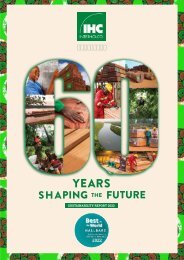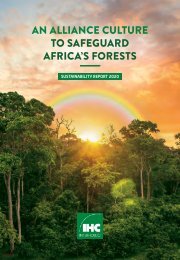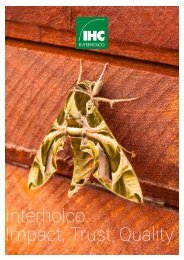Nomenclature Générale des Bois Tropicaux - 7ème édition
(english description below) Cette nomenclature est utilisée pour la mise à jour du 'Harmonized Code System' de l’Organisation Mondiale des Douanes. Dans la circulaire du 5 avril 2005, le Ministère de l’Economie, des Finances et de l’Industrie (France) reconnaît l’ATIBT comme « gardien du temple » de la nomenclature des bois tropicaux. La Commission Européenne mentionne la nomenclature de l’ATIBT comme document de référence pour la mise en œuvre du RBUE. Depuis 1954, l’ATIBT a établi et mis à jour une nomenclature des bois tropicaux faisant correspondre chaque espèce botanique avec un nom pilote reconnu internationalement. La détermination du nom pilote d’une essence est cruciale, car sa commercialisation dépend très largement de l’adoption de ce nom par le public. Le nom pilote assure la protection de l’appellation commerciale de l’essence et l’intégrité des propriétés qui lui sont attribuées, sans risque de confusion. The 1982 version of the general timber nomenclature has finally been updated as some of the 1,750 identified species, are no longer traded, while others, which were not previously included, are now on the market. The present revision has also integrated changes related to new taxonomy, in order to reflect the latest scientific developments. This Nomenclature has been used for the Harmonized Code System, updated by the World Customs Organization. The French Ministry of economy, finance and industry has given official recognition to ATIBT as the reference for the tropical timber nomenclature (NOR: PRMX0508285C of April 5th 2005). The European Commission refers to ATIBT nomenclature as a reference document for the implementation of the EUTR regulation. Since 1954, ATIBT has established and updated a nomenclature of tropical wood, linking each botanical species with an internationally recognized pilot name. A sigle wood species may have many common names; when trading across different countries, this may lead to confusion. Fixing the pilot name of a timber species is crucial, to protect the commercial denomination of the species and guarantee the veracity of the properties linked to that species, without confusion.
(english description below)
Cette nomenclature est utilisée pour la mise à jour du 'Harmonized Code System' de l’Organisation Mondiale des Douanes. Dans la circulaire du 5 avril 2005, le Ministère de l’Economie, des Finances et de l’Industrie (France) reconnaît l’ATIBT comme « gardien du temple » de la nomenclature des bois tropicaux. La Commission Européenne mentionne la nomenclature de l’ATIBT comme document de référence pour la mise en œuvre du RBUE.
Depuis 1954, l’ATIBT a établi et mis à jour une nomenclature des bois tropicaux faisant correspondre chaque espèce botanique avec un nom pilote reconnu internationalement. La détermination du nom pilote d’une essence est cruciale, car sa commercialisation dépend très largement de l’adoption de ce nom par le public. Le nom pilote assure la protection de l’appellation commerciale de l’essence et l’intégrité des propriétés qui lui sont attribuées, sans risque de confusion.
The 1982 version of the general timber nomenclature has finally been updated as some of the 1,750 identified species, are no longer traded, while others, which were not previously included, are now on the market. The present revision has also integrated changes related to new taxonomy, in order to reflect the latest scientific developments.
This Nomenclature has been used for the Harmonized Code System, updated by the World Customs Organization. The French Ministry of economy, finance and industry has given official recognition to ATIBT as the reference for the tropical timber nomenclature (NOR: PRMX0508285C of April 5th 2005). The European Commission refers to ATIBT nomenclature as a reference document for the implementation of the EUTR regulation.
Since 1954, ATIBT has established and updated a nomenclature of tropical wood, linking each botanical species with an internationally recognized pilot name. A sigle wood species may have many common names; when trading across different countries, this may lead to confusion. Fixing the pilot name of a timber species is crucial, to protect the commercial denomination of the species and guarantee the veracity of the properties linked to that species, without confusion.
You also want an ePaper? Increase the reach of your titles
YUMPU automatically turns print PDFs into web optimized ePapers that Google loves.
Liste des noms scientifiques des bois tropicaux avec renvoi au nom pilote /// 13
NOM BOTANIQUE
BOTANICAL NAME
FAMILLE
FAMILY
CONTI-
NENT
Baphia pubescens Hook. f. Leguminosae (Fabaceae) AF Okoué
Beilschmiedia spp. (AS) Lauraceae AS Medang
NOM PILOTE
PILOT NAME
Beilschmiedia p.p. (AF) Lauraceae AF Kanda brun
Beilschmiedia p.p. (AF) Lauraceae AF Kanda rose
Beilschmiedia congolana Robyns & R. Wilczek Lauraceae AF Kanda brun
Beilschmiedia corbisieri Robyns & R. Wilczek Lauraceae AF Kanda brun
Beilschmiedia gabonensis Benth. & Hook. Lauraceae AF Kanda rose
Beilschmiedia grandifolia Robyns & R. Wilczek Lauraceae AF Kanda rose
Beilschmiedia hutchinsonia Robyns & R.
Wilczek
Lauraceae AF Kanda rose
Beilschmiedia letouzeyi Robyns & R. Wilczek Lauraceae AF Kanda brun
Beilschmiedia mannii Benth. & Hook. Lauraceae AF Kanda rose
Beilschmiedia oblongifolia Robyns & R.
Wilczek
Lauraceae AF Kanda brun
Beilschmiedia obscura A. Chev. Lauraceae AF Kanda rose
Berchemia zeyheri Grubov Rhamnaceae AF Pink ivory
Berlinia spp. Leguminosae (Caesalpiniaceae) AF Ebiara
Berlinia bracteosa Benth. Leguminosae (Caesalpiniaceae) AF Ebiara
Berlinia confusa Hoyle Leguminosae (Caesalpiniaceae) AF Ebiara
Berlinia grandiflora Hutch. & Dalziel Leguminosae (Caesalpiniaceae) AF Ebiara
Berlinia seretii De Wild. (cf. Julbernardia seretii) Leguminosae (Caesalpiniaceae) AF Alumbi
Berlinia bifoliolata Harms (cf. Tetraberlinia bifoliolata)
Leguminosae (Caesalpiniaceae) AF Ekaba
Bertholletia excelsa H.B.K. Lecythidaceae AM Castanheiro
Bikinia spp. Leguminosae (Caesalpiniaceae) AF Andoung
Bikinia coriacea Wieringa Leguminosae (Caesalpiniaceae) AF Andoung
Bikinia durandii Wieringa Leguminosae (Caesalpiniaceae) AF Andoung
Bikinia le-testui Wieringa Leguminosae (Caesalpiniaceae) AF Andoung
Bikinia pellegrini Wieringa Leguminosae (Caesalpiniaceae) AF Andoung
Bischofia javanica Blume Phyllanthaceae (Euphorbiaceae) AS Gintungan
Bobgunnia fistuloides J.H. Kirkbr. & Wiersema Leguminosae (Caesalpiniaceae) AF Pao rosa
Bocoa prouacensis Aubl. Leguminosae (Caesalpiniaceae) AM Wamara
Bombacopsis quinata Dugand (cf. Pachira quinata)
Bombax rhodognaphalon K. Schum. (cf. Rhodognaphalon
schumannianum)
Malvaceae (Bombacaceae) AM Saqui-Saqui
Malvaceae (Bombacaceae) AF Kondroti
Bombax buonopozense P. Beauv. Malvaceae (Bombacaceae) AF Kapokier
Bombax ceiba L. Malvaceae (Bombacaceae) AS Kapok
Bombax chevalieri Pellegr. (cf. Rhodognaphalon
brevicuspe)
Malvaceae (Bombacaceae) AF Kondroti
Bombax costatum Pellegr. & Vuillet Malvaceae (Bombacaceae) AF Kapokier
Bombax flammeum Ulbr. (cf. B.buonopozense) Malvaceae (Bombacaceae) AF Kapokier
Bombax malabaricum A. DC. (cf. B.ceiba) Malvaceae (Bombacaceae) AS Kapok














